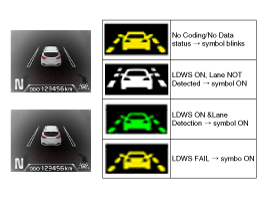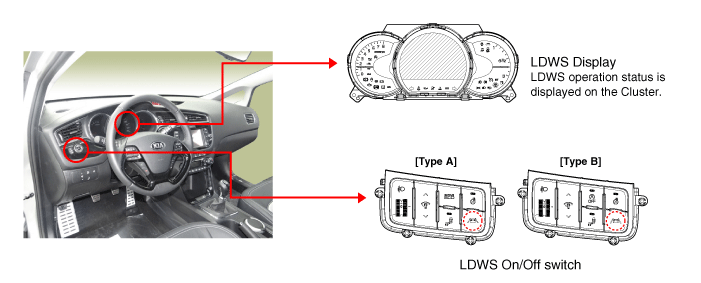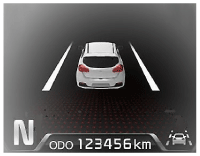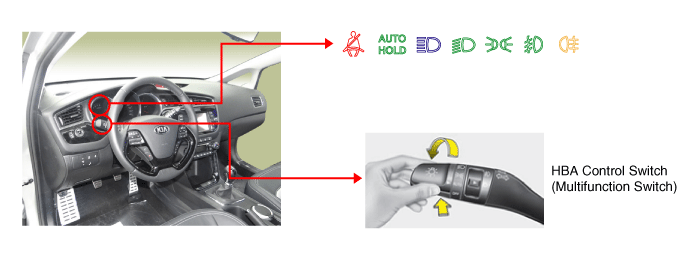Kia Cee'd: Lane Departure Warning System (LDWS) / Description and operation
Kia Cee'd JD Service Manual / Body Electrical System / Lane Departure Warning System (LDWS) / Description and operation
| Description |
Block Diagram
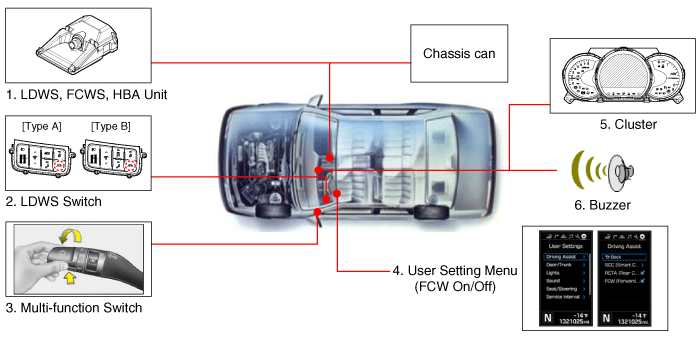
LDWS is composed of below units
|
No |
Item |
Function |
Position |
||||||||
|
1 |
LDWS UNIT |
|
Windshield Glass |
||||||||
|
2 |
LDWS Switch |
LDWS On/Off Switch |
Crash Pad (Left) |
||||||||
|
3 |
Multi-function Switch |
HBA On/Off Switch (MF : Auto mode) |
Steering Wheel |
||||||||
|
4 |
User Setting Menu |
SLIF On/Off, FCW On/Off Menu |
Cluster menu |
||||||||
|
5 |
Cluster/Buzzer |
SLIF/ FCW/LDWS Waning |
Cluster |
※ Europe : (LDWS/SLIF) / China, Middle East, Australia: (LDWS)
Camera unit of the LDWS processes the following functions using the video signal
input.
| – |
Detect and analyze drive lane
|
| – |
Detect the light from foregoing vehicle
|
| – |
Detect and analyze status of foregoing vehicle, and make warning sounds
(or message) for driver if necessary.
|
| – |
Transmits the information using high speed CAN communication
|
| 1. |
Lane Departure Warning System (LDWS) unit
The lane departure warning system is a convenient device that recognizes
the lanes ahead using the camera image and vehicle signal informtaion
and alarms the driver in case of deviation from the lane. It consists
of the camera unit and recognizes the lane by calculating the camera
image input signal.
The sensor module that processes screen image by sensing the lane ahead
on the camera unit, senses the lane and calculates key parameters, i.e.
vehicle center offset, road width, vehicle driving angle and road curvature,
to keep to the lane. The following procedures are the lane recognizing
process through screen image processing.
|
| 2. |
LDWS Operation process
When the LDWS switch is pressed, the operation state of the lane departure
warning system is displayed at the center while the LDWS lamp is on.
The specific classification of the displays is shown in the following
table.
|
||||||||||||||||||||
| 3. |
FCWS Operation process
|
||||||||||||||||||||||||
| 4. |
High Beam Assist
(Multi-function Switch Auto/High beam position)
|
||||||||||||||||||||
LDWS ON/OFF switch (A)
When the LDWS switch is pressed, the LDWS is on while the LDWS lamp is on. When
the switch is pressed again, the LDWS is off and the display lamp is off.
| [Type A] |

| [Type B] |
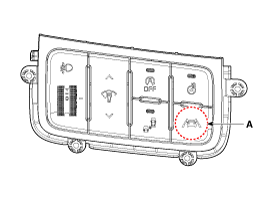
High Beam Auto Control Switch: High Beam Auto Control System is turned ON if
the Multifunction Switch Light SW is set to AUTO, and the Light SW is set to
High Beam position (Pushed).
| – |
If the Light SW is not set to AUTO, or to High Beam position, the High
Beam Auto Control System is turned OFF.
|
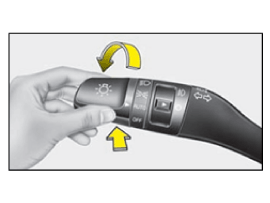
The alarm method of LDWS
| 1. |
Visual alarm : The lane to the direction of departure brinks "yellow".
|
The operating conditions of LDWS
The operating conditions of LDWS is as below.
| 1. |
The switch for LDWS shall be ON. The LDWS lamp is on in the instrument
panel when the switch is on.
|
| 2. |
It operates when the LDWS function is set and the vehicle speed exceeds
60km/h (37mph).
The alarming function is stopped tentatively when the vehicle speed
is lower than 60~55km/h (37~34mph) and the alarming is restarted when
it is over 60km/h (37mph).
|
| 3. |
If the driver operates left and right turning lamps to inform the intention
of lane change, there will be no alarm regardless of the direction of
lane departure.
The lane departure alarming function is restarted after 2 seconds from
switching off the left and right turning lamps.There will be no alarm
when operating the hazard lamps.
|
| 4. |
Operate the switch for turning lamps and then change the lane. Random
changing of lanes without operating the turning lamps to the driving
direction generates the alarm.
|
| 5. |
When more than 40% of the vehicle body has crossed the lane, the alarm
is released by sensing departure for lane change.
|
| 6. |
The lane departure alarming is not made when the vehicle drives at the
center of the lane.
|
 Components and components location
Components and components location
Components
1. LDWS ON/OFF switch
2. Instrument cluster
3. LDWS unit
...
 Repair procedures
Repair procedures
Service Point Target Auto
Calibration (SPTAC)
This procedure provides a way to calibrate the camera by having the service
technician align the car to a well lit simulated straig ...
Other information:
Kia Cee'd JD Service Manual: Specifications
Specifications
Item
Specifications
Working voltage
DC
12V
Operating force
14.7 ± 2.9N
(1.5 ± 0.3kg, 3.3 ± 0.7lb)
Working temperature
-40°C ~ 80� ...
Kia Cee'd JD Service Manual: Start/Stop Button Repair procedures
Removal
1.
Disconnect the negative (-) battery terminal.
2.
Remove the crash pad center fascia panel.
(Refer to Body - "Center Fascia Panel")
3.
Disconnect the start/stop button connecto ...


